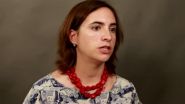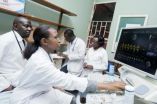(Press-News.org) BLOOMINGTON, Ind. -- Chemists at Indiana University Bloomington have described the self-assembly of large, symmetrical molecules in bricks-and-mortar fashion, a development with potential value for the field of organic electronic devices such as field-effect transistors and photovoltaic cells.
Their paper, "Anion-Induced Dimerization of 5-fold Symmetric Cyanostars in 3D Crystalline Solids and 2D Self-Assembled Crystals," has been published online by Chemical Communications, a journal of the Royal Society of Chemistry. It is the first collaboration by Amar Flood, the James F. Jackson Associate Professor of Chemistry, and Steven L. Tait, assistant professor of chemistry. Both are in the materials chemistry program in the IU Bloomington Department of Chemistry, part of the College of Arts and Sciences.
The article will appear as the cover article of an upcoming issue of the journal. The cover illustration was created by Albert William, a lecturer in the media arts and science program of the School of Informatics and Computing at Indiana University-Purdue University Indianapolis. William specializes in using advanced graphics and animation to convey complex scientific concepts.
Lead author of the paper is Brandon Hirsch, who earned the cover by winning a poster contest at the fall 2013 meeting of the International Symposium on Macrocyclic and Supramolecular Chemistry. Co-authors, along with Flood and Tait, include doctoral students Semin Lee, Bo Qiao and Kevin P. McDonald and research scientist Chun-Hsing Chen.
The researchers demonstrate the self-assembly and packing of a five-sided, symmetrical molecule, called cyanostar, that was developed by Flood's IU research team. While researchers have created many such large, cyclic molecules, or macrocycles, cyanostar is unusual in that it can be readily synthesized in a "one pot" process. It also has an unprecedented ability to bind with large, negatively charged anions such as perchlorate.
"This great piece of work, with state-of-the-art studies of the assembly of some beautiful compounds pioneered by the group in Indiana, shows how anions can help organize molecules that could have very interesting properties," said David Amabilino, nanomaterials group leader at the Institute of Materials Science of Barcelona. "Symmetry is all important when molecules pack together, and here the supramolecular aspects of these compounds with a very particular shape present tantalizing possibilities. This research is conceptually extremely novel and really interdisciplinary: It has really unveiled how anions could help pull molecules together to behave in completely new ways."
The paper describes how cyanostar molecules bind with anions in 2-to-1 sandwich-like complexes, with anions sandwiched between two saucer-shaped cyanostars. The study shows the packing of the molecules in repeating patterns reminiscent of the two-dimensional packing of pentagons shown by artist Albrecht Durer in 1525. It further shows the packing to take place not only at but away from the surface of materials.
The future of organic electronics will rely upon packing molecules onto electrode surfaces, yet it has been challenging to get packing of the molecules away from the surface, Tait and Flood said. With this paper, they present a collaborative effort, combining their backgrounds in traditionally distinct fields of chemistry, as a new foray to achieve this goal using a bricks-and-mortar approach.
The paper relies on two complementary technologies that provide high-resolution images of molecules:
X-ray crystallography, which is being celebrated worldwide for its invention 100 years ago, can provide images of molecules from analysis of the three-dimensional crystalline solids.
Scanning tunneling microscopy, or STM, developed in 1981, shows two-dimensional packing of molecules immobilized on a surface.
The results are distinct, with submolecular views of the star-shaped molecules that are a few nanometers in diameter. (A human hair is about 100,000 nanometers thick).
INFORMATION:
STM imaging was done in Tait's lab, and X-ray crystallography was conducted at the IU Molecular Structure Center. Support for the research comes from the National Science Foundation and the U.S. Department of Energy as well as Indiana University. The article is Flood's 100th publication. To speak with the researchers, contact Steve Hinnefeld, IU Communications, 812-856-3488 orslhinnef@iu.edu.
Chemists demonstrate 'bricks-and-mortar' assembly of new molecular structures
2014-07-31
ELSE PRESS RELEASES FROM THIS DATE:
Women in military less likely to drink than civilian women
2014-07-31
Los Angeles, CA (August 1, 2014) While it is known that members of the U.S. military overall are more likely to use alcohol, a new study finds that female enlistees and female veterans are actually less likely to drink than their civilian counterparts. This study was published today in Armed Forces & Society, a SAGE journal published on behalf of the Inter-University Seminar on Armed Forces and Society.
Researchers Jay Teachman, Carter Anderson, and Lucky Tedrow studied surveys of nearly 9,000 men and women who were currently members of the U.S. military or who were military ...
U-M researchers find protein that fuels repair of treatment-resistant cancer cells
2014-07-31
ANN ARBOR—Imagine you're fighting for your life but no matter how hard you hit, your opponent won't go down.
The same can be said of highly treatment-resistant cancers, such as head and neck cancer, where during radiation and chemotherapy some cancer cells repair themselves, survive and thrive. Head and neck cancer is the sixth most common cancer in the world, but the late detection and treatment resistance result in a high mortality rate.
Now, University of Michigan researchers have found that a particular protein—TRIP13—encourages those cancer cells to repair themselves. ...
Boat noise impacts development and survival of sea hares
2014-07-31
While previous studies have shown that marine noise can affect animal movement and communication, with unknown ecological consequences, scientists from the Universities of Bristol and Exeter and the École Pratique des Hautes Études (EPHE) CRIOBE in France have demonstrated that boat noise stops embryonic development and increases larval mortality in sea hares.
Sea hares, (specifically the sea slug Stylocheilus striatus used in this study) usually hatch from their eggs to swim away and later feed on toxic alga but this study, conducted in a coral reef lagoon in French ...
New international tree nut council study looks at nuts, diabetes and metabolic syndrome
2014-07-31
Two new meta-analyses involving tree nuts (almonds, Brazil nuts, cashews, hazelnuts, macadamias, pecans, pine nuts, pistachios and walnuts) were recently published in the online publications, British Medical Journal Open (BMJ Open) (i) and PLOS ONE (ii). The BMJ Open article looked at the effects of tree nuts on metabolic syndrome (MetS) criteria and showed that tree nut consumption resulted in a significant decrease in triglycerides and fasting blood glucose. The PLOS ONE article focused on the effect of tree nuts on glycemic control in diabetes and showed significant ...
Vets' alcohol problems linked to stress on the home front
2014-07-31
VIDEO:
Research findings show the important role civilian life and the accompanying stress plays in cases of alcohol use disorder among returning National Guardsmen.
Click here for more information.
Regardless of traumatic events experienced during deployment, returning National Guard soldiers were more likely to develop a drinking problem if faced with civilian life setbacks, including job loss, legal problems, divorce, and serious financial and legal problems—all commonplace ...
Veterans' alcohol problems linked to stress on the home front
2014-07-31
Ann Arbor, MI, July 31, 2014 — Regardless of traumatic events experienced during deployment, returning National Guard soldiers were more likely to develop a drinking problem if faced with civilian life setbacks, including job loss, legal problems, divorce, and serious financial and legal problems — all commonplace in military families. Results of the study by researchers at Columbia University's Mailman School of Public Health are published online in the American Journal of Preventive Medicine.
Alcohol abuse is a major concern for reservists returning home. Nearly 7% ...
Research proves there is power in numbers to reduce electricity bills
2014-07-31
Consumers can save money on their electricity bills and negotiate better deals by joining forces with similar groups of customers to switch energy suppliers according to new research.
Collective switching or group buying schemes, where thousands of consumers join forces to negotiate cheaper electricity tariffs, are becoming more popular in the UK as bills continue to rise putting increasing pressure on household budgets. Initiatives like Which?'s Big Switch, People Power or the Big Deal have helped thousands of consumers to save, on average, up to a third of their yearly ...
Engineering a protein to prevent brain damage from toxic agents
2014-07-31
Research at New York University is paving the way for a breakthrough that may prevent brain damage in civilians and military troops exposed to poisonous chemicals—particularly those in pesticides and chemical weapons.
An article in the current issue of the journal ChemBioChem outlines the advancement in detoxifying organophosphates, which are compounds commonly used in pesticides and warfare agents. The patent-pending process was developed by NYU School of Engineering Associate Professor of Chemical and Biological Engineering Jin Kim Montclare, along with Richard Bonneau, ...
Transplantation shown to be highly effective in treating immune deficiency in children
2014-07-31
Babies who are born with severe combined immunodeficiency (SCID) can be successfully treated with a transplant of blood-forming stem cells, according to experts led by Memorial Sloan Kettering's Richard J. O'Reilly, MD, a world-renowned pioneer in the development of transplant protocols. Their review will be published in the July 30 issue of the New England Journal of Medicine.
SCID is a group of inherited disorders that cause the immune system to severely malfunction. When this breakdown occurs, babies no longer have the ability to fight off routine infections because ...
Journal supplement details progress in African medical education
2014-07-31
Medical education in sub-Saharan Africa is being revitalized and expanded through a U.S.-funded effort that is dramatically increasing enrollment, broadening curricula, upgrading Internet access and providing cutting-edge skills labs and other technologies.
In the first substantial publication by participants of the $130 million Medical Education Partnership Initiative (MEPI), more than 225 authors detailed progress being made at the African institutions. Their reports are in a supplement being published today by the journal Academic Medicine. Begun in 2010, MEPI is ...


